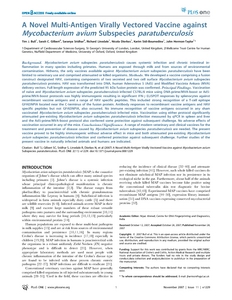Bull, TJ; Gilbert, SC; Sridhar, S; Linedale, R; Dierkes, N; Sidi-Boumedine, K; Hermon-Taylor, J
(2007)
A Novel Multi-Antigen Virally Vectored Vaccine against Mycobacterium avium Subspecies paratuberculosis.
PLOS ONE, 2 (11).
e1229.
ISSN 1932-6203
https://doi.org/10.1371/journal.pone.0001229
SGUL Authors: Bull, Timothy John
![[img]](https://openaccess.sgul.ac.uk/1499/1.hassmallThumbnailVersion/pone.0001229.pdf)  Preview |
|
["document_typename_application/pdf; charset=binary" not defined]
Published Version
Download (1MB)
| Preview
|
Abstract
BACKGROUND: Mycobacterium avium subspecies paratuberculosis causes systemic infection and chronic intestinal inflammation in many species including primates. Humans are exposed through milk and from sources of environmental contamination. Hitherto, the only vaccines available against Mycobacterium avium subspecies paratuberculosis have been limited to veterinary use and comprised attenuated or killed organisms.
METHODS: We developed a vaccine comprising a fusion construct designated HAV, containing components of two secreted and two cell surface Mycobacterium avium subspecies paratuberculosis proteins. HAV was transformed into DNA, human Adenovirus 5 (Ad5) and Modified Vaccinia Ankara (MVA) delivery vectors. Full length expression of the predicted 95 kDa fusion protein was confirmed.
PRINCIPAL FINDINGS: Vaccination of naïve and Mycobacterium avium subspecies paratuberculosis infected C57BL/6 mice using DNA-prime/MVA-boost or Ad5-prime/MVA-boost protocols was highly immunogenic resulting in significant IFN-gamma ELISPOT responses by splenocytes against recombinant vaccine antigens and a range of HAV specific peptides. This included strong recognition of a T-cell epitope GFAEINPIA located near the C-terminus of the fusion protein. Antibody responses to recombinant vaccine antigens and HAV specific peptides but not GFAEINPIA, also occurred. No immune recognition of vaccine antigens occurred in any sham vaccinated Mycobacterium avium subspecies paratuberculosis infected mice. Vaccination using either protocol significantly attenuated pre-existing Mycobacterium avium subspecies paratuberculosis infection measured by qPCR in spleen and liver and the Ad5-prime/MVA-boost protocol also conferred some protection against subsequent challenge. No adverse effects of vaccination occurred in any of the mice.
CONCLUSIONS/SIGNIFICANCE: A range of modern veterinary and clinical vaccines for the treatment and prevention of disease caused by Mycobacterium avium subspecies paratuberculosis are needed. The present vaccine proved to be highly immunogenic without adverse effect in mice and both attenuated pre-existing Mycobacterium avium subspecies paratuberculosis infection and conferred protection against subsequent challenge. Further studies of the present vaccine in naturally infected animals and humans are indicated.
| Item Type: |
Article
|
| Additional Information: |
©2007 Bull et al. This is an open-access article distributed under the terms of the Creative Commons Attribution License, which permits unrestricted use, distribution, and reproduction in any medium, provided the original author and source are credited. |
| Keywords: |
Adenoviridae, Animals, Antigens, Bacterial, Bacterial Vaccines, Base Sequence, DNA Primers, Enzyme-Linked Immunosorbent Assay, Genetic Vectors, Interferon-gamma, Mice, Mice, Inbred C57BL, Mycobacterium avium subsp. paratuberculosis, Polymerase Chain Reaction, Vaccines, Synthetic, Science & Technology, Multidisciplinary Sciences, Science & Technology - Other Topics |
| SGUL Research Institute / Research Centre: |
Academic Structure > Infection and Immunity Research Institute (INII) |
| Journal or Publication Title: |
PLOS ONE |
| ISSN: |
1932-6203 |
| Related URLs: |
|
| Dates: |
| Date | Event |
|---|
| 28 November 2007 | Published |
|
| Web of Science ID: |
WOS:000207459300011 |
  |
Download EPMC Full text (PDF)
|
 |
Download EPMC Full text (HTML)
|
| URI: |
https://openaccess.sgul.ac.uk/id/eprint/1499 |
| Publisher's version: |
https://doi.org/10.1371/journal.pone.0001229 |
Statistics
Item downloaded times since 01 May 2012.
Actions (login required)
 |
Edit Item |



